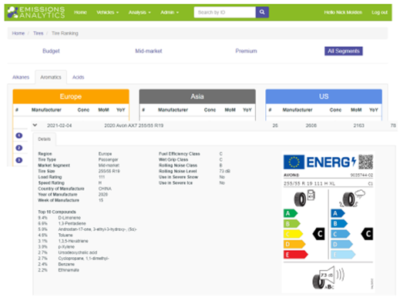

Pollution from tire wear now 1,850 times worse than exhaust emissions
By some distance, the research Emissions Analytics published in early 2020 claiming that tire particulate wear emissions were 1,000 times worse than exhaust emissions generated the most feedback of any subject we have tackled so far – feedback that was a mixture of surprise and scepticism.
Of particular attention was whether such a rate of wear would mean that any tire could be spent within just a few thousand miles with legal driving, however aggressive. Particularly vocal were the battery electric vehicle (BEV) community, sensitive to any suggestion that the added weight of these vehicles might lead to tire wear emissions that might confound the ‘zero emissions’ tag. Such was the reaction, the story was translated into over 40 languages worldwide.
Since that study, which was transparently designed to quantify the worst-case tire emissions under legal driving, Emissions Analytics has been testing and analysing tire wear emissions in more detail across a wider range of driving conditions, and has performed a detailed chemical analysis of hundreds of new tires. Furthermore, we have worked with the National Physical Laboratory in the UK objectively to quantify the uncertainties in our measurements of chemical composition.
The headline conclusion we draw now is that, comparing real-world tailpipe particulate mass emissions to tire wear emissions, both in ‘normal’ driving, the latter is actually around 1,850 times greater than the former. Yes, in normal driving the ratio is almost double the previous figure for aggressive driving.
Quoting such ratios, however, needs careful interpretation. The fundamental trends that drive this ratio are: tailpipe particulate emissions are much lower on new cars, and tire wear emissions increase with vehicle mass and aggressiveness of driving style. Tailpipe emissions are falling over time, as exhaust filters become more efficient and with the prospect of extending the measurement of particulates under the potential future Euro 7 regulation, while tire wear emissions are rising as vehicles become heavier and added power and torque is placed at the driver’s disposal. On current trends, the ratio may well continue to increase.
To measure tire wear mass emissions, Emissions Analytics uses high-precision scales to weigh all four wheels – tires and rims together, without detaching – over at least 1,000 miles on real roads. This is coupled with a proprietary sampling system that collects particles at a fixed point immediately behind each tire, which are, via a sample line, drawn into a real-time detector measuring the size of distribution of particles by mass and number. Typically, this measures particles from 10 microns down to 6 nanometres. This combination allows the real-time signal to be calibrated to the mass loss, and, by using the size distribution, the proportion of the particles likely to be suspended in the air can be estimated. All tire emissions figures quoted here are for the whole vehicle, combining wear from the four tires.
Tailpipe particles are measured, in similar real-world conditions, using a diffusion charger analyser for dynamic mass concentration and a condensing particle counter for number concentration, both coupled with a standard Portable Emissions Measurement System (PEMS) to measure total exhaust flow. As a result, distance-specific mass and number emissions can be derived, which can then be compared to equivalent tire metrics. A summary of the results is shown in the table and chart below.

The comparison is best illustrated by way of a bar chart with a logarithmic vertical scale, as shown below.

The aggressive legal driving is the result from 2020, which was derived from a Volkswagen Golf driven at legal road speeds on a track, with fast cornering and maximum permitted payload in the vehicle. The normal driving results were averaged across 14 different brands of tire tested on a Mercedes C-Class driven with average dynamics on the road, with just the driver and no payload in the vehicle. All of these tires were tested from new. A smaller number of tires were then tested over their full lifetime in order to estimate the degree to which wear rates declined over time.
The tailpipe real-world emissions were measured across four gasoline mid-sized sports utility vehicles from 2019 and 2020 model years, driven on a mix of urban and motorway routes. The payload was the driver and test equipment only. For these vehicles, the relevant regulated limit value in Europe – which is the same limit in force for current vehicles – was 4.5 mg/km for mass and 6.0 x 1011 #/km for number.
Quite remarkably, but as testament to the filtration efficiency of the latest gasoline particulate filters (GPFs), tailpipe mass emissions are now as low as 0.02 mg/km. Gasoline vehicles were tested as they represent the majority of new passenger cars sold today. Therefore, the mass wear from new tires is 16 times greater than the maximum permitted from the tailpipe, but 3,650 times greater than actual tailpipe emissions. Taking the full-life average tire emissions, that premium falls to the 1,850 times mentioned earlier. The excess emissions under aggressive driving should alert us to a risk with BEVs: greater vehicle mass and torque delivered can lead to rapidly increasing tire particulate emissions. Half a tonne of battery weight can result in tire emissions that are almost 400 more times greater than real-world tailpipe emissions, everything else being equal. Nevertheless, it is important to say that a gentle BEV driver, with the benefit of regenerative braking, can more than cancel out the tire wear emissions from the additional weight of their vehicle, to achieve lower tire wear than an internal combustion engine vehicle driven badly.

An important difference between tire and tailpipe particle emissions is that most of the former is understood to go straight to soil and water, whereas most of the latter is suspended in air for a period, and therefore negatively affects air quality. This is supported by Emissions Analytics’ results, which suggest around 11% of the mass of tire emissions is smaller than 2.5 microns in diameter (defining the common metric for fine particle dust, PM2.5, which can be airborne). Therefore, the airborne tire emissions are more likely to be around 8 mg/km as shown in the table above – this is still more than 400 times higher than tailpipe emissions.
However, considering just tire mass emissions may underestimate the effect on air quality and the consequent human health effects. The particulate number can be estimated, as shown in the second table. When measuring particle number, the lower size cut-off is important – the smaller the particles get, the more volatile and harder to measure repeatably they become. Cutting off at 23 nm avoids these ‘semi-volatiles’, whereas 6 nm is a much more comprehensive range.
This shows that 13.4 x 1011 #/km are in the size range between 6 nm and 23 nm, which represent 92% of all particles below the 10 micron upper limit that defines PM10. Growing scientific evidence suggests that these ultrafine particles more easily enter the human bloodstream and lungs, and cross into the brain. The 14.5 x 1011 #/km for the whole size range should also be compared to the maximum number permissible from the tailpipe of 6.0 x 1011 #/km at a 23 nm cut-off, and the actual real-world values from Emissions Analytics’ EQUA test programme of 0.9 x 1011 #/km for gasoline vehicles and 0.1 x 1011 #/km for diesels. Therefore, tires create more than double the particle number emissions of the tailpipe, averaged across those two fuel types. Put another way, tires may release an extra sixty billion particles for every kilometre driven.
While the body of research on the health of effects of ultrafine particles is growing, how bad these effects are is likely to depend on how toxic the particles are. Light-duty tires are typically made up of synthetic rubber, derived from crude oil, rather than natural rubber, together with various fillers and additives. In a recent newsletter, Emissions Analytics set out its initial findings from chemical analysis of the organic compounds in a range of tires using two-dimensional gas chromatography and time-of-flight mass spectrometry. This showed that there were hundreds of different compounds in each tire, with a significant proportion being aromatics, some of which are recognised carcinogens.
The next stage is then to take that chemical profile and study the toxicity of each. Our research so far shows that the least toxic tires are one-third as toxic as the worst – this will be the subject of a future newsletter. Therefore, tires not only vary significantly in wear rates, but also in chemical composition and toxicity. This potentially points to an effective way to drive reductions in wear and toxicity through economic incentives and regulation.

Bringing all these elements together, Emissions Analytics will be publishing the chemical composition and toxicity of hundreds of different tires in a subscription database that will be launched in mid-May 2022. The aim is to bring transparency and insight to an area that has historically been under-researched, but which has now been thrown into the spotlight with ever-heavier vehicles and rapidly cleaning tailpipes. We are looking to talk to anyone interested in research in this area.